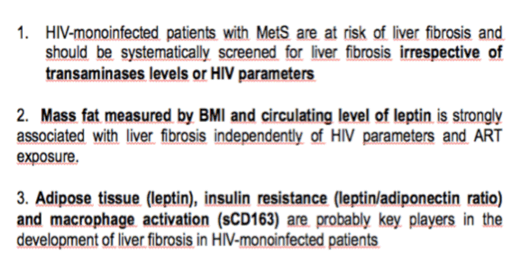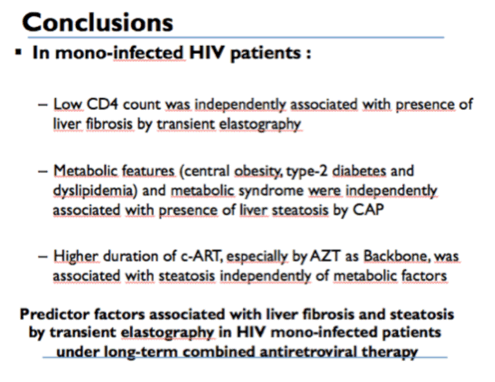 |
 |
 |
| |
HIV-infected individuals at high risk of non-alcoholic fatty liver disease (NAFLD) and progressive liver disease- ILC 2019: Latest studies confirm increasing burden of NAFLD in people with HIV infection as viral hepatitis prevalence and associated mortality decline
|
| |
| |
from Jules: I identified this - fatty liver disease in HIV+ - as a coming problem 12 years ago but no one would listen.
"The records of >47,000 HIV-infected Medicare recipients in the USA were searched, and >10,000 individuals with liver disease were identified: 5,628 with HCV-related disease, 1,374 with HBV-related disease, 645 with HCV/HBV-related disease, 2,629 with NAFLD, and 198 with other liver diseases. During the 10 years between 2006 and 2016, the prevalence rates for viral hepatitis decreased from 27.75 to 24.17 per 100,000 population (p=0.009) whilst the rates for NAFLD more than doubled from 5.32 to 11.62 per 100,000 population (p<0.001). Mortality rates related to viral hepatitis also decreased from 3.78 to 2.58 per 100,000 population (p=0.006), whilst mortality related to NAFLD increased from 0.18 to 0.80 per 100,000 population (p=0.041)." EASL press release
'Applying current NAFLD guidelines developed for HIV-negative populations, we have identified significant proportions of patients with HIV infection at risk of NAFLD and progressive liver disease,'
NATAP Section dedicated to Fatty Liver http://www.natap.org/liver.htm
IAS: Metabolic syndrome and obesity are the cornerstones of liver fibrosis in HIV-monoinfected patients: results of the METAFIB study - (07/25/17)

IAS: Predictor factors associated with liver fibrosis and steatosis by transient elastography in HIV mono-infected patients under long-term combined antiretroviral therapy - (07/26/17)

CROI: Changes in Liver Fibrosis and Steatosis in HIV Mono-Infected patients over 24 months - 50% have fatty liver at average age of 46 - (03/28/17)
from Jules: there is no doubt to me that the old nukes - AZT, ddI, d4T - caused fatty liver. HIV itself causes fatty liver, which was found in this study, and unsuppressed viral load & low nadir CD4 contribute to fatty liver. The metabolic syndrome caused by HIV which persists depute suppressed HIV & high CD4s I am sure contributes to fatty liver. Again, diet & exercise are important, but more important is to pay greater attention to this health hazard particularly as HIV patient population ages. There are no really reliable biomarkers so more research is needed. But fatly liver, hepatic steatosis can cause severe liver disease & fibrosis, this needs more attention in HIV because we still do not have much data on the contribution of each ART & class, ARTs used in this modern era.
CROI: LIVER STEATOSIS AND FIBROSIS IN AT-RISK EUROPEAN HIV-MONOINFECTED PATIENTS - 64% with steatosis among those who had elevated LFTs and/or metabolic syndrome and/or lipodystrophy - (03/28/17)
from Jules: this was a cross sectional study looking at HIV infected without hepatitis C or B but who had elevated liver enzymes - >1.5 >ULN which is not very high - they report 64% with significant staetosis & 9% with worse, NASH, and a many patients also with accompanying liver fibrosis. Many HIV+ individals have elevated liver enzymes but this appears to get past some of their doctors, not thinking perhaps they have fatty liver , the doctors may not be aware that elevated LFTs may be due to steatosis, they may think all HIV+ merely have this & they accept it without knowing what it could mean.
Fatty Liver in HIV - (07/18/17)
------------------------------
HIV-infected individuals at high risk of non-alcoholic fatty liver disease (NAFLD) and progressive liver disease
ILC 2019: Latest studies confirm increasing burden of NAFLD in people with HIV infection as viral hepatitis prevalence and associated mortality decline
11 April 2019, Vienna, Austria
EASL (EUROPEAN ASSOCIATION FOR THE STUDY OF THE LIVER)
The increasing burden and risk of non-alcoholic fatty liver disease (NAFLD) associated with HIV infection have today been highlighted in two studies presented at The International Liver Congress™ 2019 in Vienna, Austria. These studies found that, whilst prevalence and mortality rates associated with viral hepatitis in HIV-infected individuals have been declining, rates associated with NAFLD are increasing, leading to a risk of progressive liver disease.
People living with HIV infection appear to be at greater risk of developing NAFLD than the general population.1 The prevalence of NAFLD worldwide has been estimated to be 25%,2 while the prevalence in populations with HIV has been far higher in most reported studies.1,3,4 NAFLD represents an important risk factor for the development and progression of liver disease,5 and with the availability of effective hepatitis B and C antiviral medications, it is conceivable that NAFLD could become the most prominent liver disease affecting individuals with HIV in the future.3
The first study presented in Vienna aimed to assess the prevalence and mortality trends of NAFLD, viral hepatitis, and other liver diseases in HIV-infected individuals. The records of >47,000 HIV-infected Medicare recipients in the USA were searched, and >10,000 individuals with liver disease were identified: 5,628 with HCV-related disease, 1,374 with HBV-related disease, 645 with HCV/HBV-related disease, 2,629 with NAFLD, and 198 with other liver diseases. During the 10 years between 2006 and 2016, the prevalence rates for viral hepatitis decreased from 27.75 to 24.17 per 100,000 population (p=0.009) whilst the rates for NAFLD more than doubled from 5.32 to 11.62 per 100,000 population (p<0.001). Mortality rates related to viral hepatitis also decreased from 3.78 to 2.58 per 100,000 population (p=0.006), whilst mortality related to NAFLD increased from 0.18 to 0.80 per 100,000 population (p=0.041).
'Our study shows that, as highly effective treatments for HBV and HCV infections lead to reduced associated mortality in HIV-infected populations, NAFLD is becoming an increasingly important cause of liver disease,' said Dr Zobair Younossi, Professor and Chairman of the Department of Medicine at Inova Fairfax Medical Campus in Falls Church, Virginia, USA, who presented the study results.
The second study, involving teams from Canada, the UK and Italy, used a diagnostic algorithm based on current EASL guidelines in HIV-negative populations6 to identify individuals with NAFLD from two cohorts of adults with living with HIV without significant alcohol intake or viral hepatitis coinfection (the LIVEr disease in HIV [LIVEHIV] and Modena HIV Metabolic Clinic [MHMC] cohorts). Of the 1,228 HIV-infected individuals reviewed (mean age 50 years; 73% males; time since diagnosis 16 years), 31.8% had NAFLD. Based on elevated alanine aminotransferase (ALT) levels and/or significant fibrosis, 25.2% of these patients were considered to be at risk of progressive liver disease compared with 18.4% of patients without NAFLD. Independent predictors of liver disease progression requiring specialist referral were found to be male sex, diabetes, and duration of HIV infection.
'Applying current NAFLD guidelines developed for HIV-negative populations, we have identified significant proportions of patients with HIV infection at risk of NAFLD and progressive liver disease,' said Dr Sila Cocciolillo from the Royal Victoria Hospital, McGill University Health Centre, Montreal, Canada. 'We think this supports the need for dedicated monitoring of these patients, with referral to hepatology services when required.'
Professor Philip Newsome (Vice-Secretary, EASL) said, "These studies indicate the changing profile of liver disease in patients with HIV - whilst viral hepatitis is still the major cause of liver disease in such groups, NAFLD is becoming a much commoner problem. This reinforces the need to study of therapeutic agents in patients with NAFLD and HIV, an area which is seldom examined."
###
About The International Liver Congress™
This annual congress is the biggest event in the EASL calendar, attracting scientific and medical experts from around the world to learn about the latest in liver research. Attending specialists present, share, debate and conclude on the latest science and research in hepatology, working to enhance the treatment and management of liver disease in clinical practice. This year, the congress is expected to attract approximately 10,000 delegates from all corners of the globe.
The International Liver Congress™ 2019 will take place from 10-14 April 2019 at the Reed Messe Wien Congress and Exhibition Center, Vienna, Austria.
https://easl.eu/ About The European Association for the Study of the Liver (EASL)
Since its foundation in 1966, this not-for-profit organization has grown to over 4,000 members from all over the world, including many of the leading hepatologists in Europe and beyond. EASL is the leading liver association in Europe, having evolved into a major European association with international influence, and with an impressive track record in promoting research in liver disease, supporting wider education and promoting changes in European liver policy.
Onsite location references
Session title: 'NAFLD - Clinical burden natural history'
Time, date and location of session: 17:15-17:30, 11 April 2019, Strauss 1-2
Presenter: Zobair Younossi, USA
Abstract: The increasing importance of non-alcoholic fatty liver disease in human deficiency virus (HIV) positive patients (PS-062)
Session title: 'NAFLD: Diagnostics and non-invasive assessment'
Time, date and location of session: 09:00-17:00, 13 April 2019, Poster Area
Presenter: Sila Cocciolillo, Canada
Abstract: Application of guidelines for fatty liver in two prospective cohorts of human immunodeficiency virus positive patients (SAT-286)
Author disclosures
Zobair Yonoussi has received consulting fees from Gilead, Intercept, Bristol-Myers Squibb, Novo Nordisk, Shinogi and Novartis.
Sila Cocciolillo has no relevant disclosures
References
1 MauriceJB, et al. Prevalence and risk factors of nonalcoholic fatty liver disease in HIV-monoinfection. 2017;31(11):1621-32.
2 Younossi ZM, et al. Global epidemiology of nonalcoholic fatty liver disease - Meta-analytic assessment of prevalence, incidence, and outcomes. 2016;64(1):73-84.
3 Rockstroh JK. Non-alcoholic fatty liver disease (NAFLD) and non-alcoholic steatohepatitis (NASH) in HIV. Curr HIV/AIDS Rep. 2017;14(2):47-53.
4 Verna EC. Non-alcoholic fatty liver disease and non-alcoholic steatohepatitis in patients with HIV. Lancet Gastroenterol Hepatol. 2017;2(3):211-23.
5 KasparMB, Sterling Mechanisms of liver disease in patients infected with HIV. BMJ Open Gastroenterol. 2017;4(1):e000166.
European Association for the Study of the Liver (EASL); European Association for the Study of Diabetes (EASD); European Association for the Study of Obesity (EASO). EASL-EASD-EASO Clinical Practice Guidelines for the management of non-alcoholic fatty liver disease. J Hepatol. 2016;64(6):1388-402.
|
| |
|
 |
 |
|
|